
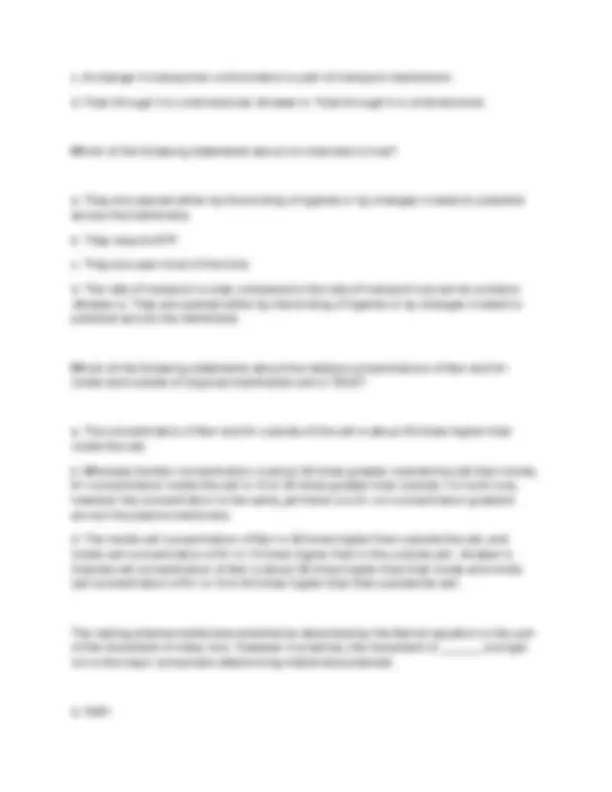






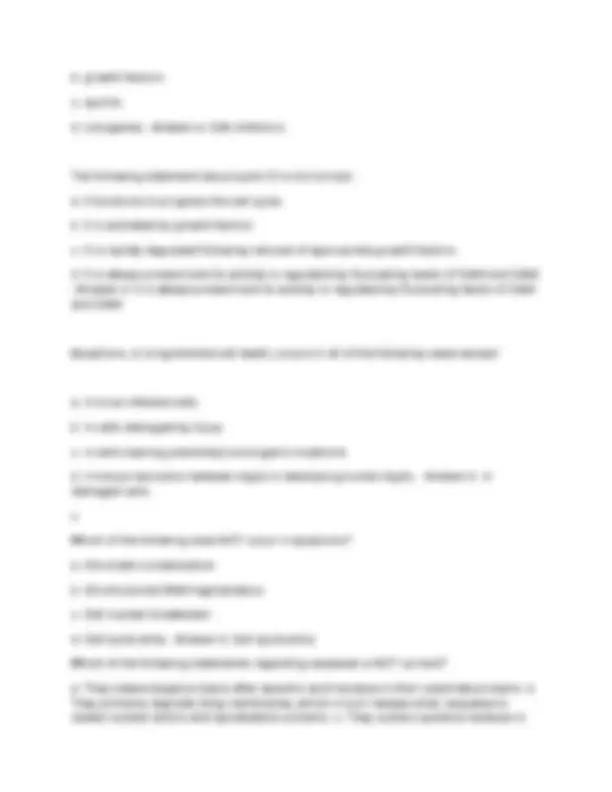


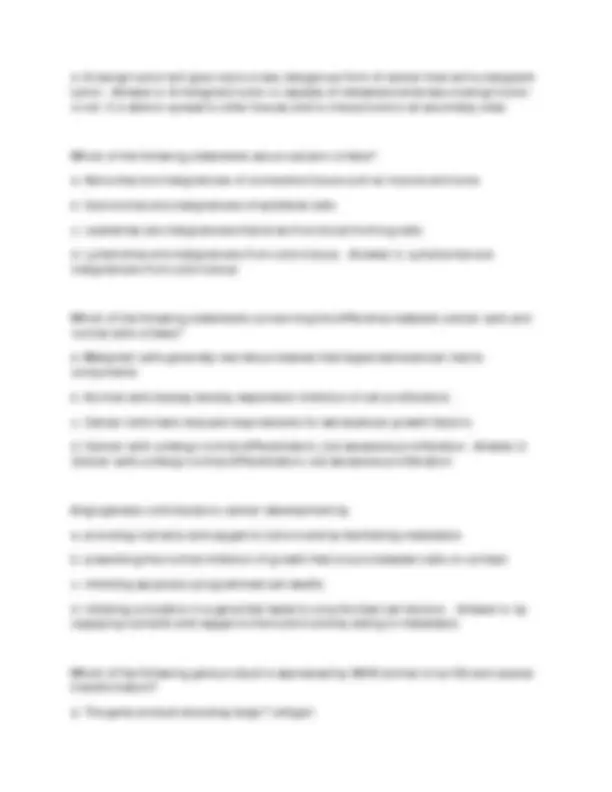

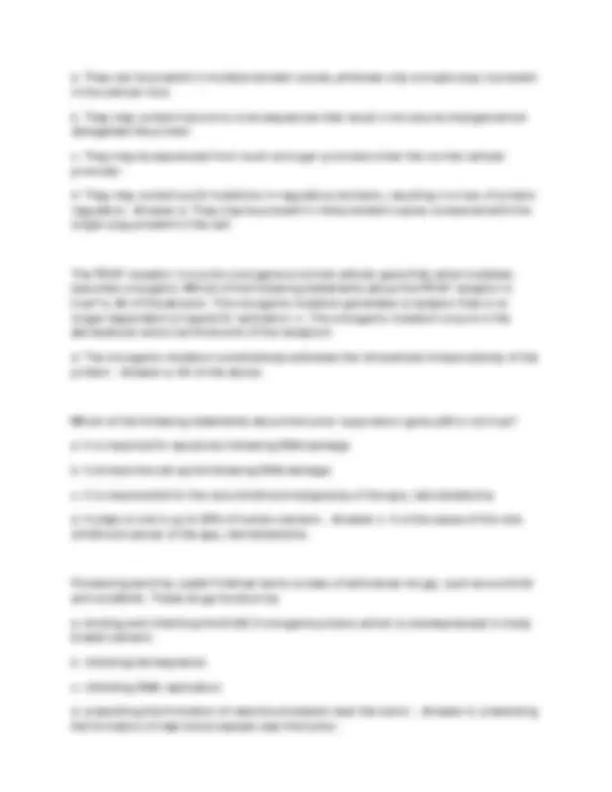
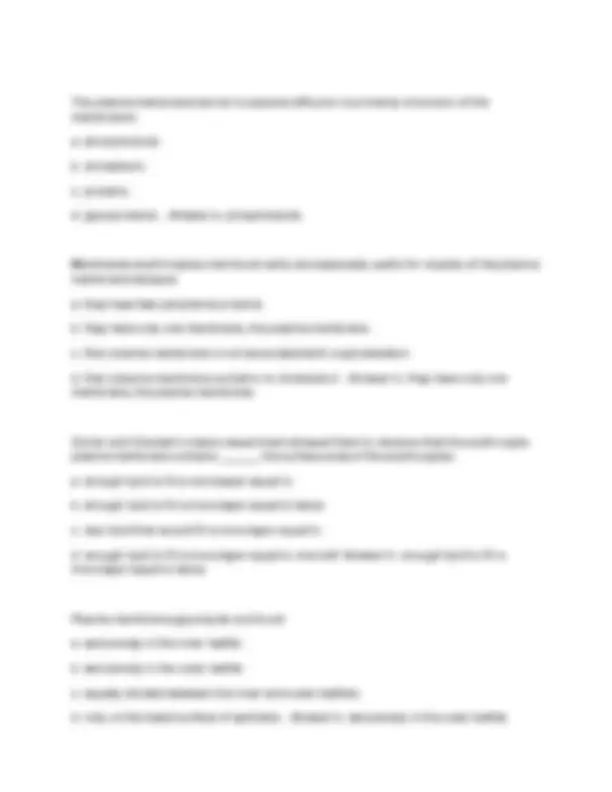

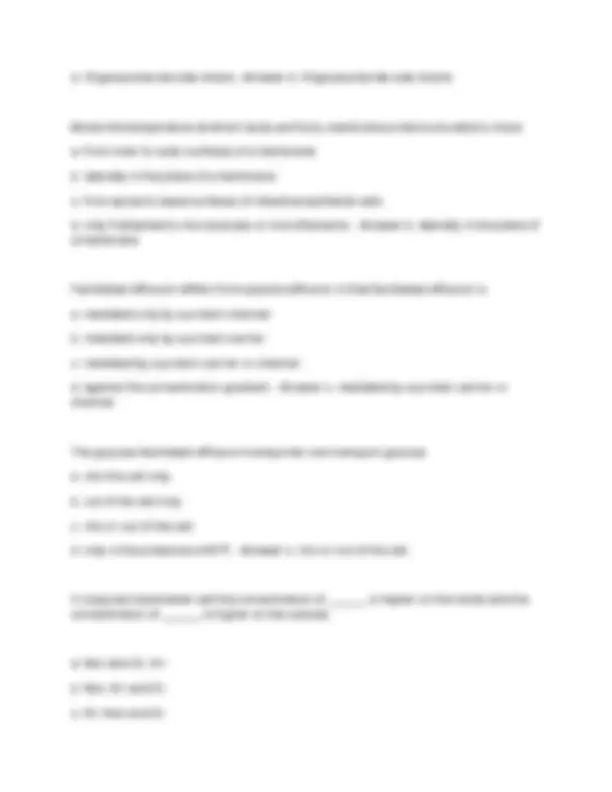



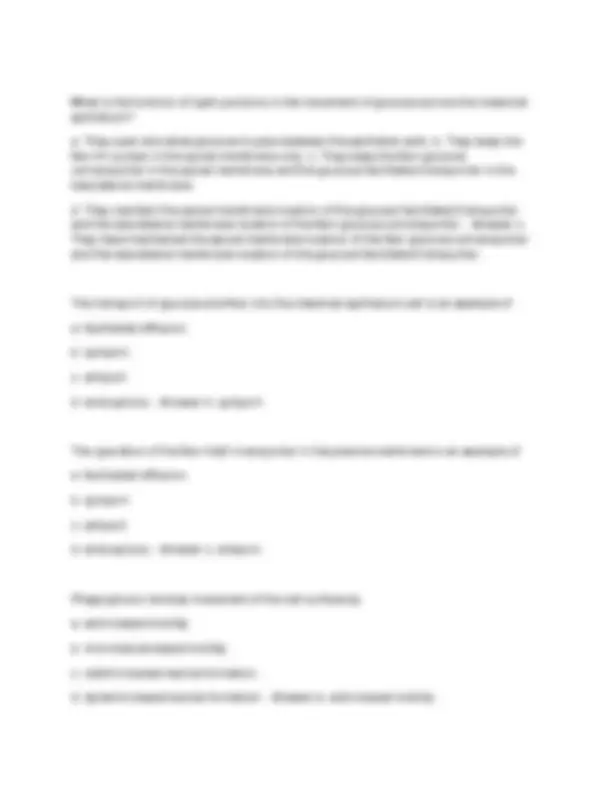






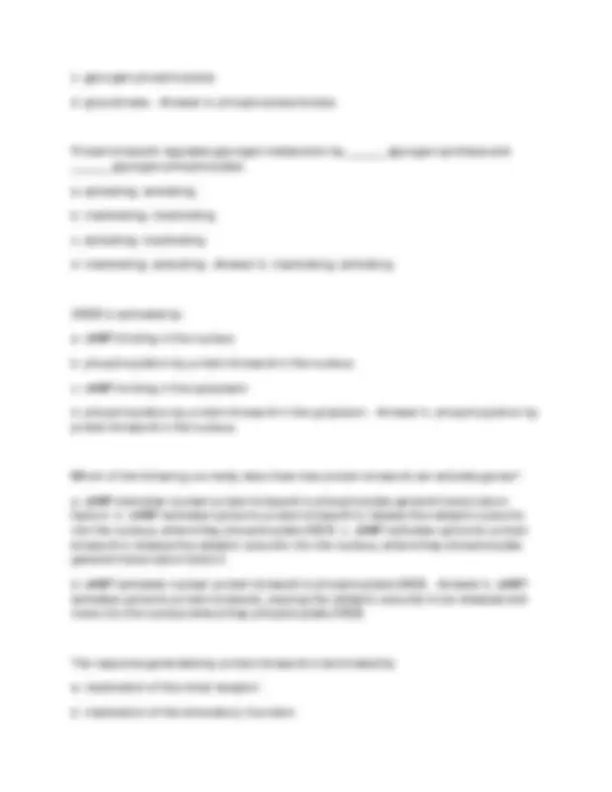















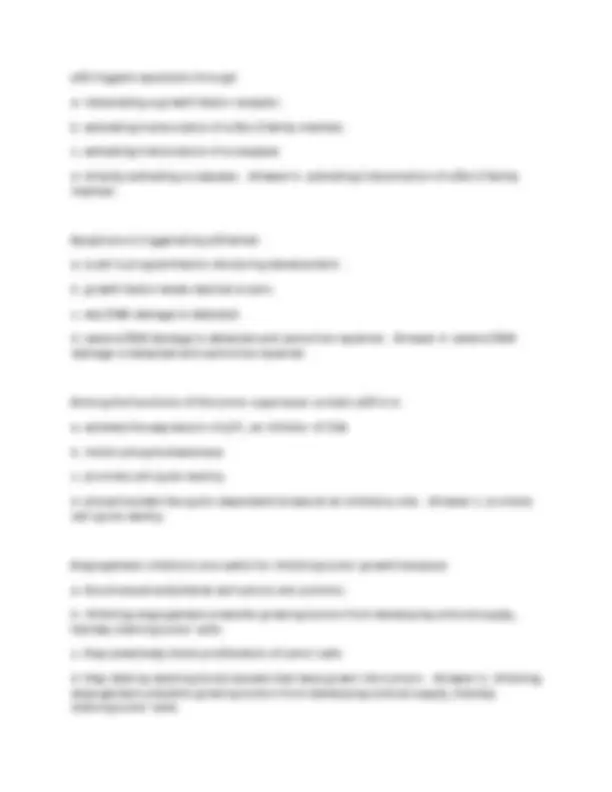




Study with the several resources on Docsity

Earn points by helping other students or get them with a premium plan


Prepare for your exams
Study with the several resources on Docsity

Earn points to download
Earn points by helping other students or get them with a premium plan
Community
Ask the community for help and clear up your study doubts
Discover the best universities in your country according to Docsity users
Free resources
Download our free guides on studying techniques, anxiety management strategies, and thesis advice from Docsity tutors
A series of multiple-choice questions and answers related to the structure and function of the plasma membrane, focusing on topics such as membrane lipids, membrane proteins, ion channels, and transport mechanisms. It covers key concepts like facilitated diffusion, active transport, endocytosis, and cell signaling pathways. The questions are designed to test understanding of the molecular components and processes that govern membrane function, including the roles of cholesterol, sphingolipids, g-protein-coupled receptors, and various transport proteins. This material is useful for students studying cell biology and biochemistry, providing a concise review of essential membrane biology concepts. The document also touches on the mechanisms of receptor-mediated endocytosis and the role of signaling molecules like nitric oxide and cyclic amp.
Typology: Exams
1 / 53

This page cannot be seen from the preview
Don't miss anything!














































What is the primary reason mammalian red blood cells are used for studies of the plasma membrane?
a. They are abundant and comparatively easy to obtain. b. They have larger plasma membranes than all other cell types. c. They are of particular interest because they are composed of a lipid monolayer. d. They lack nuclei and membrane-bounded organelles. Answer d. They lack nuclei and membrane-bounded organelles.
Two examples of membrane lipids that are present in small amounts are
a. cholesterol and phosphatidylcholine. b. glycolipids and phosphatidylinositol. c. phosphatidylcholine and sphingomyelin. d. phosphatidylethanolamine and phosphatidylserine. - Answer b. glycolipids and phosphatidylinositol.
Which of the following lipids are distinctly enriched in lipid rafts?
a. Cholesterol and sphingolipids b. Glycolipids and phosphatidylinositol c. Phosphatidylcholine and sphingomyelin d. Phosphatidylethanolamine and phosphatidylserine - Answer a. Cholesterol and sphingolipids
Which of the following will not solubilize a typical peripheral membrane protein?
a. Detergent b. Extreme pH c. High salt concentration d. Mildly hypertonic saline Answer d. Mildly hypertonic saline
A feature common to most transmembrane proteins is
a. a phosphorylated exterior domain. b. an α-helical region of about 20 to 25 hydrophobic amino acids. c. an amino acid sequence rich in acidic residues. d. a structure consisting almost exclusively of β-sheets. Answer b. an α-helical region of about 20 to 25 hydrophobic amino acids.
Membrane proteins are able to move
a. from the inner to the outer surface of a membrane. b. laterally within the plane of a membrane. c. from apical to basal surfaces of intestinal epithelial cells. d. only if attached to microtubules or microfilaments. - Answer b. laterally within the plane of a membrane.
Which of the following statements about the glucose transporter is false? a. It moves glucose across the plasma membrane by a process called "facilitated diffusion." b. It has 12 α-helical transmembrane segments.
b. Cl- c. K+ d. Na+ - Answer c. K+
Although Na+ is smaller than K+, its passage through the K+ channel is blocked by the _______ filter.
a. CO b. negativity c. positivity d. selectivity - Answer d. selectivity
Active transport differs from facilitated diffusion in that
a. ions are not transported via active transport, only by facilitated diffusion. b. active transport requires a protein component, whereas facilitated diffusion occurs by simple diffusion through the plasma membrane. c. active transport involves the transport of molecules up their concentration gradient. d. active transport involves a conformational change in the transport molecule. - Answer c. active transport requires the movement of molecules up their concentration gradient.
Transport of glucose into the intestinal epithelium is energized by ion gradients established by the
a. ATP pump. b. H+ pump. c. Na+-K+ pump. d. K+ channel. - Answer c. Na+-K+ pump.
Which of the following statements about ABC transporters is NOT true?
a. Each member of a family has an ATP-binding cassette. b. Each member of the family is a Cl- channel. c. They are the largest family of membrane transporters in humans. d. Each member of the family has shared domain structure features. - Answer b. Each member of the family is a Cl- channel.
The ingestion of large particles by cells is a form of endocytosis known as a. fluid phase endocytosis. b. pinocytosis. c. phagocytosis. d. transcytosis. - Answer c. phagocytosis.
Which one of the following does not participate in receptor-mediated endocytosis? a. Clathrin b. Adaptor proteins c. Internalization signals d. Pseudopodia - Answer d. Pseudopodia
LDL uptake by cells is one of the functions of: a. receptor-mediated endocytosis. b. phagocytosis. c. caveolae. d. ABC transporters. - Answer a. receptor-mediated endocytosis.
Mutations in the internalization signal of endocytic receptors block their interaction with
Which one of the following does not constitute a therapeutic effect of aspirin? a. Stimulating growth of fibroblasts at the site of wound, hence aiding the healing process b. Reducing inflammation and pain c. Reducing blood clotting d. Reducing the risk of colon cancer - Answer a. The stimulation of fibroblast proliferation allowing wound healing
G-protein-coupled receptors are one of the major classes of signal transduction molecules in cell membranes. Which of the following statements about G-protein-coupled receptors is correct? a. They may be activated only by steroid hormones. b. They interact with only guanine nucleotides c. They interact with both adenine and guanine nucleotides. d. They generally contain seven membrane-spanning α helices - Answer d. They generally contain seven membrane-spanning α helices
Which of the following statements about heterotrimeric G proteins in their resting state is correct?
a. GDP is bound to the β subunit in a complex with both the α and γ subunits. b. GDP is bound to the α subunit in a complex with both the β and γ subunits. c. GTP is bound to the α subunit in a complex with both the β and γ subunits. d. The proteins are in a complex with G protein-coupled receptors. - Anwer b. GDP is bound to the α subunit in a complex with both the β and γ subunits.
Which one of the following statements about G protein signaling is NOT true? a. Binding of the hormone promotes an interaction of the receptor with the G protein that stimulates the release of GDP and the exchange of GTP on the α subunit. b. The activated GTP-bound α subunit dissociates from βγ and interacts with its target. c. Activity of the α subunit is terminated by hydrolysis of the GTP to GDP.
d. The α subunit becomes deactivated when the hormone dissociates from the receptor.
Answer d. The α subunit becomes deactivated when the hormone dissociates from the receptor.
Cyclic AMP (cAMP) is synthesized from ATP by the action of: a. phosphodiesterase. b. phosphorylase kinase. c. adenylyl cyclase. d. protein kinase A (PKA). Answer c. adenylyl cyclase.
Most of the effects of cyclic AMP (cAMP) in the cell are mediated by a. protein kinase A. b. ion channels. c. protein kinase C. d. cAMP phosphodiesterase - Answer a. protein kinase A.
Which of the following statements regarding PKA is/are incorrect?
a. In its inactive state, PKA is a tetramer comprised of two regulatory (R) and two catalytic (C) subunits. b. PKA binds a total of four molecules of cAMP, one on each of the four subunits. c. PKA binds a total of four molecules, two molecules on each of the two regulatory (R) subunits. d. Once activated, the catalytic (C) subunits dissociate and activate target molecules. -Answer b. PKA binds a total of four molecules of cAMP, one on each of the four subunits.
Receptor protein-tyrosine kinases are key molecules that signal in growth and
b. the extracellular matrix to the cytoskeleton. c. focal adhesions to hemidesmosomes. d. microtubules to actin filaments. - Answer b. the extracellular matrix to the cytoskeleton.
Which of the following is a distinctive feature of the MEK kinaseMAP kinase/ERK kinase? a. its activation by a kinase b. its position downstream of G proteincoupled receptors c. its dual-specificity kinase activity, with the ability to phosphorylate both threonines and tyrosines d. its action as an activator of a kinase Ans c is a dual-specificity kinase, having the ability to phosphorylate both threonines and tyrosines.
Heterotrimeric G proteins are not the only guanine nucleotide-binding proteins. Which of the following also is a family of GTP-binding proteins that function as monomers rather than being a heterotrimeric complex? a. Ras b. ERK c. Raf d. Smad -Answer a. Ras
Which is an example of signaling by direct cell-cell interactions a. the Wingless (Wnt) signaling pathway. b. the JAK/STAT pathway. c. the Notch pathway. d. the pathway leading to vulval development in C. elegans. - Answer c. the Notch pathway.
In unstimulated cells, NF-κB proteins are maintained in an inactive state in the cytosol by interactions with
a. Hedgehog. b. IκΒ. c. adaptor proteins. d. the TNF receptor. - Answer b. IκΒ.
Interphase is defined as a. the G1, G2, and S phases. b. G0, the quiescent phase. c. the G1 and G2 phases. d. M phase. - Answer a. the G1, G2, and S phases.
Stage of the cell cycle that is defined as the time between mitosis and the start of DNA replication is called the
a. G1 phase. b. G2 phase. c. S phase. d. M phase. - Answer a. G1 phase.
You expose a radiolabeled nucleotide to the medium of a cell culture. Which phase of the cell cycle would you expect cells that took up the radiolabel to be in? a. G1 phase b. M phase c. G2 phase d. S phase - Answer d. S phase
In which of the following cell types does G1 and G2 not occur?
e. Most cells in an adult animal are a. undergoing meiosis. b. actively proliferating. c. stem cells. d. in G0, or quiescent, phase. - Answer d. in G0, or quiescent, phase.
Cell cycle checkpoints ensure that complete genomes are transmitted to daughter cells. DNA damage checkpoints are found in all of the following phases except a. G2 phase. b. M phase. c. G1 phase. d. S phase. - Answer b. M phase.
The G2 cell cycle checkpoint detects a. chromosome misalignment. b. levels of p53. c. the binding of the MCM proteins to origins of replication. d. unreplicated or damaged DNA. - Answer d. unreplicated or damaged DNA.
Which of the following statements about cyclin B is not true? a. It builds up through S and G2. b. It activates Cdc2 protein kinase. c. It is part of MPF. d. It oscillates between active and inactive states through the cell cycle. -Answer d. It oscillates between active and inactive states through the cell cycle.
The proteins p21 and p15 are the following a. Cdk inhibitors.
b. growth factors. c. cyclins. d. oncogenes. -Answer a. Cdk inhibitors.
The following statement about cyclin D is not correct: a. It functions to progress the cell cycle. b. It is activated by growth factors. c. It is rapidly degraded following removal of appropriate growth factors. d. It is always present and its activity is regulated by fluctuating levels of Cdk4 and Cdk
Apoptosis, or programmed cell death, occurs in all of the following cases except
a. in virus-infected cells. b. in cells damaged by injury. c. in cells bearing potentially tumorigenic mutations. d. in tissue resorption between digits in developing human digits. - Answer b. in damaged cells. c Which of the following does NOT occur in apoptosis? a. Chromatin condensation b. Chromosomal DNA fragmentation c. Cell nuclear breakdown d. Cell cycle entry - Answer d. Cell cycle entry Which of the following statements regarding caspases is NOT correct? a. They cleave target proteins after aspartic acid residues in their substrate proteins. b. They primarily degrade Golgi membranes, which in turn release other caspases to cleave nuclear lamins and cytoskeleton proteins. c. They contain cysteine residues in
The following is a signal transduction cascade, with one missing step, initiated by double-stranded DNA damage and terminating with the activation of apoptosis by the BH3-only proteins PUMA and Noxa: Double-stranded DNA damage; Chk2; _______; PUMA/Noxa; apoptosis. Which protein occupies the blank space? a. Apaf- b. p c. Chk d. Bax - Answer b. p
PI 3-kinase pathway counteracts apoptosis in normal cells promoting cell survival. Which of the following statements concerning the PI 3-kinase pathway is not true? a. PI 3-kinase phosphorylates PIP2 to form PIP3. b. PIP3 activates Akt, a serine/threonine kinase. c. PI 3-kinase is activated by a receptor tyrosine kinase. d. Activated Akt phosphorylates and activates Bad - Answer d. Activated Akt phosphorylates and activates Bad
TNF and related cytokines can directly induce apoptosis. Which of the following statements about TNF-mediated induction of apoptosis is correct? a. TNF binds a trimeric receptor complex on the surface of the cell membrane. b. Caspase-8 activates Bid, which in turn activates Bax and Bak and then feeds into the mitochondrial pathway. c. All of the above d. After receptor binding, caspase-8 is activated by an adaptor protein. c. All of the above Some differentiated cells do remain proliferative to replace lost or damaged cells during the life of an animal. Which of the following cell types do not possess this special ability? a. Neurons b. Epithelial cells c. Endothelial cells d. Fibroblasts -Answer a. Neurons
For the questions below about stem cells, select which of the following is not true. a. Stem cells represent a subpopulation of less-differentiated self-renewing cells that exist in most adult tissues. b. Stem cells in organs can only differentiate into the tissue in which they reside. c. Tissue stem cells reside in G0 in most cases, unless they are asked to differentiate. d. Stem cells divide to form one daughter cell that remains a stem cell and a second cell that proliferates and then differentiates. - Answer b. Stem cells in organs can only
differentiate into the tissue in which they are located.
Which of the following is/are not considered a viable source of stem cells? a. Umbilical cord blood b. An embryo c. Tumors d. Bone marrow - Answer c. Tumors
Which of the following cell types cannot arise from hematopoietic stem cells?
a. B lymphocytes b. Platelets c. Macrophages d. Satellite cells -Answer d. Satellite cells
Which of the following patients would be likely candidates for bone marrow transplantation?
a. Immune deficiencies b. All of the above c. Hemoglobin disorders d. Aplastic anemia -Answer b. All of the above
Which of the following stem cells have the ability to give rise to all the differentiated cell types of adult organisms? a. Endothelial cells b. Epithelial cells c. Satellite cells
d. A benign tumor will give rise to a less dangerous form of cancer than will a malignant tumor. -Answer a. A malignant tumor is capable of metastasis whereas a benign tumor is not. It is able to spread to other tissues and to induce tumors at secondary sites.
Which of the following statements about cancers is false? a. Sarcomas are malignancies of connective tissue such as muscle and bone. b. Carcinomas are malignancies of epithelial cells. c. Leukemias are malignancies that arise from blood-forming cells. d. Lymphomas are malignancies from colon tissue. - Answer d. Lymphomas are malignancies from colon tissue.
Which of the following statements concerning the difference between cancer cells and normal cells is false? a. Malignant cells generally secrete proteases that digest extracellular matrix components. b. Normal cells display density-dependent inhibition of cell proliferation. c. Cancer cells have reduced requirements for extracellular growth factors. d. Cancer cells undergo normal differentiation, but excessive proliferation. -Answer d. Cancer cells undergo normal differentiation, but excessive proliferation.
Angiogenesis contributes to cancer development by a. providing nutrients and oxygen to tumors and by facilitating metastasis. b. preventing the normal inhibition of growth that occurs between cells on contact. c. inhibiting apoptosis (programmed cell death). d. initiating a mutation in a gene that leads to uncontrolled cell division. - Answer a. by supplying nutrients and oxygen to the tumors and by aiding in metastasis.
Which of the following gene product is expressed by SV40 (simian virus 40) and causes transformation? a. The gene product encoding large T antigen
b. E c. EIA d. E1B - Answer a. The gene product encoding large T antigen
Which of the following statements about papillomaviruses is NOT true? a. They mainly infect epithelial cells. b. When infected, they cause the expression of E6 and E7, which is transformed. c. They have been implicated to cause both malignant and benign breast cancer. d. They create benign and malignant tumors in humans. -Answer c. They have been implicated to cause both malignant and benign breast cancer.
Humans affected with HIV are more susceptible to certain types of cancers due to the fact that a. of the expression of the viral gene tax. b. the virus encodes a protein that binds and inactivates the tumor suppressor gene p53. c. these individuals are immunosuppressed. d. the virus integrates into the genome and alters the pattern of expression of adjacent genes. - Answer c. these individuals are immunosuppressed
Most oncogene proteins are a. metabolic enzymes b. components of signaling pathways that control cell proliferation c. cell sorting proteins. d. structural proteins, including nuclear lamins. - Answer b. components of signaling pathways that control cell growth.
Which of the following does not represent a way in which oncogenes carried by viral genomes may differ from their cellular homologs (proto-oncogenes)?